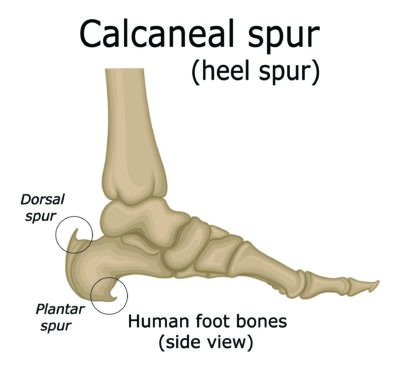What is a Heel Spur?
Heel bone spurs are small, bony protrusions that can severely limit mobility and make even walking around the home a burdensome and painful chore. Fortunately, many people suffering from foot pain related to bone spurs can experience symptom relief with nonsurgical options.
Heel spurs are basically just excess calcium deposits that collect on the bottom of the heel bone over a long period of time. The formation of these bony growths may be related to other conditions or lifestyle factors. For example, improperly fitting or poorly padded shoes may lead to the development of heel spurs.
Overweight individuals have an increased risk of developing heel bone spurs, as do individuals with arthritis and certain gait abnormalities, such as overpronation (also known as flat feet). The strain on the bones and connective tissues of the foot from exercises such as running and jogging may also contribute to the growth of heel bone spurs.
How Do You Treat Heel Spurs?
Once we properly diagnosed it, your podiatrist at Family Foot & Ankle Physicians will recommend appropriate heel bone spur treatment.

Fortunately, many patients are able to achieve adequate relief from bone spur pain with nonsurgical heel spur treatment. For patients who are overweight, losing excess pounds may help reduce the stress on the affected foot and heel during weight-being activities. For athletes suffering from bone spur pain, it may be necessary to reduce the intensity and frequency of activities known to cause symptom flare-ups. For those with milder heel spur symptoms, it may be possible to perform adequate heel spur treatment at home, with a regimen of rest, ice, compression, and elevation (R.I.C.E.).
Additionally, nonsteroidal anti-inflammatory meds can be taken to assist with general pain and swelling following rigorous activities and during symptom flare-ups.
Depending on the severity of the condition, cortisone heel spur injections may also help reduce pain and swelling. However, it’s important to note that these shots will only offer temporary heel spur pain relief, and patients will need to return for cortisone heel spur injections throughout the year for long-lasting results. Our physicians can help determine the best care plan for you.
What Is Heel Spur Surgery Entail?
If the previous nonsurgical treatment options have failed to relieve a person’s heel spur pain, surgery may be necessary.
Once your specific condition has been diagnosed, your provider will discuss your specific heel spur surgery options. If this is the case, your doctor may recommend a procedure known as plantar fascia release. During a plantar fascia release surgery, the surgeon will remove a portion of the ligament to reduce inflammation and pain. This procedure may be performed as an endoscopic or open procedure. Your Family Foot & Ankle Physicians doctor will recommend one of these procedures based on your specific condition. During a typical heel spur removal surgery, our physicians will remove the calcium deposit along the heel. This procedure may also be either open or endoscopic, and like plantar fascia release, this will vary on a case-by-case basis.
Family Foot & Ankle Physicians has a primary location in Greenville, servicing cities such as Greenville, Farmville, Ahoskie, Kinston, Winterville, Tarboro, New Bern, Edenton, Washington, Rocky Mount, with patients coming from throughout eastern North Carolina and beyond.
